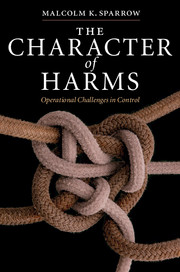Book contents
- Frontmatter
- Contents
- List of figures
- Acknowledgments
- Introduction
- Part I The nature of the control task
- 1 Which way up, and does it matter?
- 2 A different type of work
- 3 Defining problems: setting the scale
- 4 Defining problems: picking the dimensions
- 5 Patterns of thought and action
- 6 Puzzles of measurement
- 7 Structures, protocols, and interactions
- Part II Special categories of harms
- Conclusion
- Index
5 - Patterns of thought and action
from Part I - The nature of the control task
Published online by Cambridge University Press: 06 July 2010
- Frontmatter
- Contents
- List of figures
- Acknowledgments
- Introduction
- Part I The nature of the control task
- 1 Which way up, and does it matter?
- 2 A different type of work
- 3 Defining problems: setting the scale
- 4 Defining problems: picking the dimensions
- 5 Patterns of thought and action
- 6 Puzzles of measurement
- 7 Structures, protocols, and interactions
- Part II Special categories of harms
- Conclusion
- Index
Summary
In the harm-reduction business, one source of stress for practitioners is ambiguity. Something should be done, because some set of harms is not sufficiently controlled. Somebody should act, and yet there is no system or protocol that specifies whose job it is, nor how much discretion they have, nor what range of methods anyone is authorized to consider.
A very different form of stress results when practitioners find themselves unambiguously accountable for results that matter. In the harm-reduction business, that most often involves accountability for harms reduced. People responsible and accountable for reducing harms are motivated to action or driven to despair depending, of course, on whether they have any real possibility of success. Rigidity in the organization, lack of support from necessary partners, and lack of power to reallocate resources or adopt new techniques can minimize the prospects for success of any kind.
Executives, temporarily removed from the constraints of their own organizations, can explore together how they would like to behave in response to unambiguous pressure for results, if only it were possible. It doesn't take long in an executive classroom setting for practitioners to work out together how they think their organizations ought to approach a harm-reduction task. Once that discussion is done, the serious work for them then is to figure out what it would take to make their respective institutions adopt those rather-easy-to-specify patterns of thought and action as a core competence.
- Type
- Chapter
- Information
- The Character of HarmsOperational Challenges in Control, pp. 101 - 122Publisher: Cambridge University PressPrint publication year: 2008



